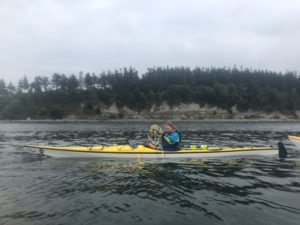 These past few months have been a particular challenge for our volunteer scientists. We were impressed at how many stepped up to continue collecting valuable data. But our North Sound Stewards community science volunteer of the quarter, Melanie Conner Lyons, has not only demonstrated a true commitment to community science, but did so during a very turbulent and transitional period for the science program and the whole community alike.
These past few months have been a particular challenge for our volunteer scientists. We were impressed at how many stepped up to continue collecting valuable data. But our North Sound Stewards community science volunteer of the quarter, Melanie Conner Lyons, has not only demonstrated a true commitment to community science, but did so during a very turbulent and transitional period for the science program and the whole community alike.
Tell us about yourself! What are some things you like to do?
I enjoy working and playing outside whenever possible, especially if it involves loading up sea kayaks or raft gear for multi-day island or river excursions. I also enjoy backpacking and long summer days.
I’ve always noticed the water quality alert signs at Larrabee State Park, but never really thought about how it is that the data collection and testing which informs these important public notifications actually happens.
What inspired you to join North Sound Stewards?
I was inspired to join because I wanted an opportunity to not only learn more about the natural world around me, but also to participate in the preservation and research of the local waterways which I value so very much.
What has been the most fun, memorable, or impactful experience you’ve had as a North Sound Steward?
One of my most memorable experiences as a volunteer was participating in the Bull Kelp survey at Point Whitehorn. I enjoyed that it was kayak-based and required team participation. It was a really fun opportunity to meet other people with similar interests while collecting data and samples for scientific research.
I am a part of the beach sampling program which tests for enterococci (sewage) bacteria levels at Little Sqaulicum and Larrabee State Park beaches. For this, I collected weekly water samples and other data including water temperature and salinity, weather and tide conditions, and general observations. I also participated in the green crab survey (facilitated though the Stillaguamish Tribe) and various webinars.
Tell us something you’ve learned through the program that really sticks with you.
I really learned how impactful the work is. For example, I’ve always noticed the water quality alert signs at Larrabee State Park, but never really thought about how it is that the data collection and testing which informs these important public notifications actually happens.
If you had one thing to tell others about community science, what would it be?
Community science is a fun way to get involved in preserving our natural treasures and meet new people!
How do you hope people will stay connected with protecting our waters during this time?
I think it’s important to recognize one’s own personal responsibility in protecting our water, whether it’s cleaning up dog poop so that it doesn’t contaminate water, picking up micro trash on beaches or joining the citizen science program — everyone has a role to play.
The next volunteer we celebrate could be you! Become a community science volunteer today.
